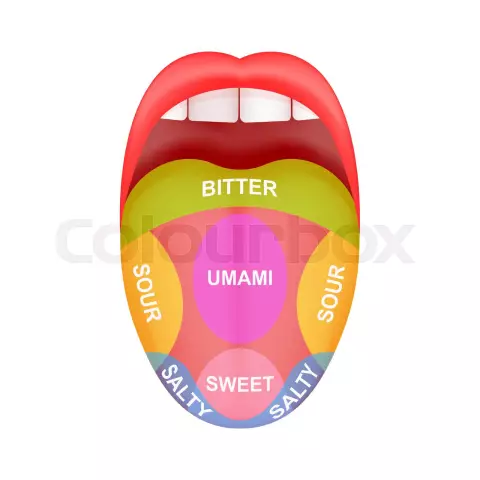- Author Rachel Wainwright [email protected].
- Public 2023-12-15 07:39.
- Last modified 2025-11-02 20:14.
Monosodium glutamate
Description of substance

Monosodium glutamate is a monosodium salt of glutamic acid - a white crystalline powder, soluble in water. Upon contact with liquids, the substance decomposes into glutamate anions and sodium cations. In the food industry, monosodium glutamate is called "flavor enhancer" and is registered under the code E621.
The chemical formula of the substance is C 5 H 8 NNaO 4.
Glutamic acid (glutamine) is one of the most widely found nonessential amino acids in nature and is found in almost all protein products. These include cow's milk, cheese, eggs, beef, duck, corn, green peas, tomatoes and a few others. Glutamine is a biologically active substance, a neurotransmitter (a substance capable of transmitting impulses from one nerve cell to another), the main building material of the human body, a nootropic agent that improves the functioning of the brain. Glutamic acid is also used as a medicinal product, providing stimulating and psychostimulating effects on the human body.
The taste enhancer monosodium glutamate is a derivative of glutamic acid artificially synthesized by humans, and for this reason does not have the above advantages.
The effect of monosodium glutamate is based on increasing the sensitivity of the receptors of the tongue by increasing the conductivity of the nerve channels and the strength of the nerve impulse - an effect that lasts for 20 minutes after consuming a food supplement. The taste of MSG is called "meaty" or "broth-like" - it can enhance the natural taste of products from meat, fish, poultry, vegetables, mushrooms and is widely used in Korean, Japanese and Chinese cuisines. In Japan, the taste of MSG is referred to as the "fifth taste" (in addition to sour, salty, sweet and bitter) and is called "umami", that is, "delicious."
Use of monosodium glutamate
The industrial use of the food additive dates back to Japan, where for many years food was seasoned with glutamic acid-rich algae extract.
A chemically pure substance produced by fermentation from carbohydrates was first obtained in 1907 by Ikeda Kikunae, an employee of the Tokyo Imperial University, who received a patent for a method for the production of food preparations, according to which the first monosodium glutamate was produced. Since 1960, monosodium glutamate E 621 has become a common food supplement, and its annual consumption in the world has reached 200,000 tons.
The flavor enhancer monosodium glutamate is widely used in meat, sausages, bouillon cubes, seasonings, sauces, frozen and canned semi-finished products, industrial crackers, chips, fast food and many other products.
This substance is included in the list of raw materials:
- “Canned lunch dishes for special consumers. Technical conditions "(GOST 18487-80);
- “Concentrates of food first and second meals for instant meals. Technical conditions "(GOST 50847-96);
- “Canned fish. Pates. Technical conditions "(GOST 7457).
The harm of monosodium glutamate
In the course of numerous controversies and studies, monosodium glutamate E621 has been recognized as a conditionally safe food additive when consumed in maximum permissible amounts. There was no evidence of a clear negative effect on the human body of monosodium glutamate in reasonable dosages.
However, the negative effects of the dietary supplement on the mammalian body have been identified. In the course of studies of the Japanese scientist Hiroshi Oguro, feeding rats with monosodium glutamate in the amount of 20% of all food consumed, a thinning of the retina was found and, as a result, a complete loss of vision. According to the explanations for the experiment, monosodium glutamate binds to receptors in retinal cells, reducing the ability of other cells to conduct nerve impulses. In addition, a large amount of the food additive was found in the intraocular fluid washing the retina.

However, Hiroshi Oguro subsequently expressed doubts about the purity of the experiment, since the conditions in which the experimental rats were placed cannot be transferred to living people. “Thus,” the scientist says, “consumption of the substance in small quantities is acceptable.”
The harm of monosodium glutamate with systematic use in large quantities is manifested by the so-called "Chinese restaurant syndrome": redness of the face, neck, mouth area, palpitations, headache. In addition, it was found that the food additive E621 damages brain cells, increases the risk of developing Alzheimer's disease, and also causes drug addiction, including in children, contributing to overeating. Since the manufacturer, in pursuit of profit, actively adds the flavor enhancer MSG to food, the consumer often switches to unbalanced food with an excess of calories, which affects both his weight and the health of the gastrointestinal tract.
It is worth noting that monosodium glutamate E621 causes a persistent dependence: by eating food with a food additive, a person constantly gets used to its rich taste, and all other dishes seem bland to him. As a result, a person consumes much more food with a specific taste than he should, losing the habit of such healthy dishes as cereals, stewed vegetables, soups without "bouillon cubes" and salads.
In order to minimize the harm of monosodium glutamate, you must:
- If possible, avoid the use of "fast food" and semi-finished products;
- Eat food prepared at home from raw food purchased at the supermarket or market;
- Do not use bouillon cubes, but buy pure seasonings;
- Carefully read the composition of the product on the package, avoiding the presence of the food additive E621 and its derivatives.
Found a mistake in the text? Select it and press Ctrl + Enter.






